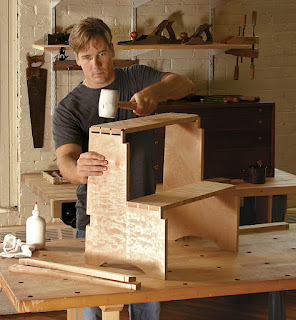Woodworking Plans for Beginners: Step-by-Step Guides
Woodworking Plans for Beginners: Step-by-Step Guides
Hey there, future woodworkers! So you're thinking about taking the plunge into the wonderful world of woodworking? Fantastic! It's a rewarding hobby that combines creativity, problem-solving, and the satisfying smell of freshly cut wood. But where do you even begin? Don't worry, I've got you covered. This guide is packed with beginner-friendly projects and tips to help you get started on your woodworking journey.
Getting Started: Tools and Safety
Before you dive into building your masterpiece (even a small one!), you'll need a few essential tools. Don't feel pressured to buy everything at once. Start with the basics and gradually expand your collection as you gain experience.
Essential Tools for Beginners:
- Measuring Tape: Accurate measurements are crucial. Get a reliable tape measure that's easy to read.
- Pencil: For marking your cuts and designs. A carpenter's pencil is ideal as it leaves a clear mark.
- Hand Saw: A good quality hand saw is perfect for beginners, allowing you to learn proper sawing techniques. A coping saw is also helpful for intricate cuts.
- Screwdriver (Phillips and Flathead): For assembling projects that use screws.
- Hammer: For driving nails (though screws are generally preferred for beginners).
- Safety Glasses: This is non-negotiable. Protect your eyes from flying wood chips and debris.
- Work Gloves: Protect your hands from splinters and rough wood.
- Clamps: Essential for holding pieces together while gluing or screwing them.
Safety First! Always wear safety glasses, and consider a dust mask if you're working with power tools later on. Work in a well-lit, organized space. Take your time, and don't rush the process. A little patience goes a long way in woodworking.
Your First Projects: Simple and Satisfying
Starting with simple projects builds confidence and teaches you fundamental techniques. Here are a few ideas to get you going:
1. A Simple Shelf:
This is a classic beginner project. All you need are some planks of wood (pine is inexpensive and easy to work with), screws, and a drill. Measure, cut, and assemble the planks to create a basic shelf. This project teaches you about measuring, cutting, and basic assembly.
2. A Wooden Coasters Set:
Cut squares or circles from scrap wood and sand them smooth. You can personalize these coasters with paint, stain, or even burning designs. This project emphasizes sanding techniques and finishing touches.
3. A Birdhouse:
A little more challenging, but still manageable for beginners. You can find free plans online for simple birdhouses. This project introduces you to more complex cuts and assembly techniques.
4. A Key Holder:
This project is perfect for practicing your cutting, sanding, and finishing skills. You can make a simple key holder from a single piece of wood, or get creative with multiple pieces and designs. Adding hooks is a great way to improve your skills further.
Moving on to More Advanced Projects (Eventually!)
Once you've mastered the basics, you can move on to more complex projects. These projects require more advanced tools and techniques, but the satisfaction of completing them is immense!
Intermediate Projects:
- Small Table: A coffee table or end table is a great intermediate project. It involves more precise measurements, joinery techniques, and finishing.
- Picture Frame: Making a picture frame involves miter cuts, precise assembly, and finishing. It's a great way to practice your joinery skills.
- Cutting Board: Cutting boards require careful planning, precise cuts, and attention to detail. The choice of wood is crucial for durability and food safety.
Remember, even more advanced projects start with simple steps. Don't be afraid to break down complex projects into smaller, manageable tasks. Each completed step brings you closer to your finished masterpiece!
Resources for Woodworking Plans
Finding woodworking plans is easier than ever. There are countless resources available online and in print:
- Online Woodworking Communities: Join online forums and groups to connect with other woodworkers, share ideas, and ask for help.
- Websites with Free Plans: Many websites offer free woodworking plans for all skill levels. Just search for "free woodworking plans for beginners."
- Woodworking Magazines and Books: Magazines and books provide detailed plans, instructions, and tips from experienced woodworkers.
- YouTube Tutorials: YouTube is a treasure trove of woodworking tutorials. Many creators offer step-by-step guides for various projects.
Remember to always check the reviews and ratings before selecting a plan to ensure it's suitable for your skill level and has clear instructions.
Commonly Asked Questions
Here are some questions beginners frequently ask:
- Q: What type of wood should I use for my first project? A: Pine is a great option for beginners because it's inexpensive, easy to work with, and readily available.
- Q: How do I choose the right woodworking plans? A: Start with simple projects that match your skill level. Look for plans with clear instructions and diagrams.
- Q: What if I make a mistake? A: Don't worry! Mistakes happen to everyone. Woodworking is a learning process. If you make a mistake, you can often fix it or start over.
- Q: What are the best finishing techniques for beginners? A: Simple sanding followed by a clear coat of varnish or polyurethane is a good starting point.
- Q: How much will it cost to get started? A: You can start with basic hand tools for a relatively low cost. As you progress, you can gradually invest in more advanced power tools.
- Q: Where can I find scrap wood? A: Check with local lumberyards, construction sites (with permission!), and even your own home for reusable wood.
So there you have it! Woodworking can be a challenging but incredibly rewarding hobby. Don't be afraid to get your hands dirty, experiment, and most importantly, have fun!


0 comments:
Post a Comment
Note: only a member of this blog may post a comment.